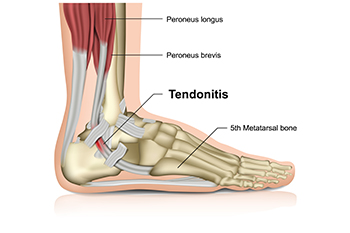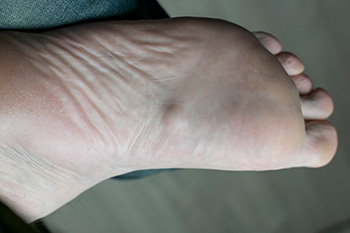
Diabetic peripheral neuropathy is a common issue for individuals with type 2 diabetes, with nearly half experiencing this complication. This condition arises when prolonged high blood sugar levels cause damage to the nerves, especially in the feet and lower legs. Symptoms of peripheral neuropathy include numbness, tingling, burning sensations, and muscle weakness, which can progressively disrupt daily activities. A significant concern is “diabetic foot,” where the loss of feeling and poor blood flow can lead to ulcers, infections, and in severe cases loss of limb. Diabetic neuropathy also can increase the risk of falls and fractures due to lack of sensation in the feet, impaired balance and reduced coordination. Factors such as smoking, high blood pressure, obesity, and cholesterol issues can further increase the risk of developing this diabetic peripheral neuropathy. Early detection and proper management are of extreme importance. If you notice unusual sensations in your feet or lower legs, especially persistent numbness or pain, it is suggested that you make an appointment with a podiatrist who can conduct a thorough examination and recommend a personalized treatment plan.
Neuropathy
Neuropathy can be a potentially serious condition, especially if it is left undiagnosed. If you have any concerns that you may be experiencing nerve loss in your feet, consult with Dr. Lubrina Bryant from District Podiatry, PLLC. Our doctor will assess your condition and provide you with quality foot and ankle treatment for neuropathy.
What Is Neuropathy?
Neuropathy is a condition that leads to damage to the nerves in the body. Peripheral neuropathy, or neuropathy that affects your peripheral nervous system, usually occurs in the feet. Neuropathy can be triggered by a number of different causes. Such causes include diabetes, infections, cancers, disorders, and toxic substances.
Symptoms of Neuropathy Include:
Those with diabetes are at serious risk due to being unable to feel an ulcer on their feet. Diabetics usually also suffer from poor blood circulation. This can lead to the wound not healing, infections occurring, and the limb may have to be amputated.
Treatment
To treat neuropathy in the foot, podiatrists will first diagnose the cause of the neuropathy. Figuring out the underlying cause of the neuropathy will allow the podiatrist to prescribe the best treatment, whether it be caused by diabetes, toxic substance exposure, infection, etc. If the nerve has not died, then it’s possible that sensation may be able to return to the foot.
Pain medication may be issued for pain. Electrical nerve stimulation can be used to stimulate nerves. If the neuropathy is caused from pressure on the nerves, then surgery may be necessary.
If you have any questions, please feel free to contact our office located in Washington, D.C . We offer the newest diagnostic and treatment technologies for all your foot care needs.

Achilles tendonitis is an inflammation of the Achilles tendon, the band connecting the calf muscles to the heel bone. This condition often arises from overuse, such as repetitive stress from activities like running or jumping. It can also result from a sudden increase in exercise intensity, wearing poor footwear, or tight calf muscles. Symptoms can include pain and stiffness along the tendon, especially in the morning or after physical activity. Relief options focus on reducing inflammation and promoting healing. Resting the affected foot can alleviate pain and swelling. Taking anti-inflammatory medications can also help to provide additional relief. Gentle stretching and strengthening exercises may restore flexibility and prevent future issues. Additionally, wearing supportive footwear and orthotics can also aid recovery. If you have pain in your heel and calf area, it is suggested that you consult a podiatrist who can accurately diagnose and treat an Achilles tendon injury.
Achilles tendon injuries need immediate attention to avoid future complications. If you have any concerns, contact Dr. Lubrina Bryant of District Podiatry, PLLC. Our doctor can provide the care you need to keep you pain-free and on your feet.
What Is the Achilles Tendon?
The Achilles tendon is a tendon that connects the lower leg muscles and calf to the heel of the foot. It is the strongest tendon in the human body and is essential for making movement possible. Because this tendon is such an integral part of the body, any injuries to it can create immense difficulties and should immediately be presented to a doctor.
What Are the Symptoms of an Achilles Tendon Injury?
There are various types of injuries that can affect the Achilles tendon. The two most common injuries are Achilles tendinitis and ruptures of the tendon.
Achilles Tendinitis Symptoms
Rupture Symptoms
Treatment and Prevention
Achilles tendon injuries are diagnosed by a thorough physical evaluation, which can include an MRI. Treatment involves rest, physical therapy, and in some cases, surgery. However, various preventative measures can be taken to avoid these injuries, such as:
If you have any questions please feel free to contact our office located in Washington, D.C . We offer the newest diagnostic tools and technology to treat your foot and ankle needs.

Morton's neuroma is a painful condition affecting the ball of the foot, resulting from a thickening of tissue around a nerve, often between the third and fourth toes. Symptoms include a burning sensation, tingling, or numbness in the affected area, along with the feeling of a small pebble or lump underfoot. Pain may worsen with activity or wearing tight shoes. Treatment options for Morton's neuroma focus on relieving pressure on the affected nerve. This includes wearing shoes with a wider toe box or adding padding to support the arch and alleviate pressure. Avoiding activities that worsen symptoms also helps. Podiatrists may recommend corticosteroid injections to reduce inflammation, or in severe cases, surgical removal of the neuroma. Early intervention ensures effective management, relieving discomfort and restoring foot function. Visiting a podiatrist is suggested for a precise diagnosis and personalized treatment plan.
Morton’s neuroma is a very uncomfortable condition to live with. If you think you have Morton’s neuroma, contact Dr. Lubrina Bryant of District Podiatry, PLLC. Our doctor will attend to all of your foot care needs and answer any of your related questions.
Morton’s Neuroma
Morton's neuroma is a painful foot condition that commonly affects the areas between the second and third or third and fourth toe, although other areas of the foot are also susceptible. Morton’s neuroma is caused by an inflamed nerve in the foot that is being squeezed and aggravated by surrounding bones.
What Increases the Chances of Having Morton’s Neuroma?
Morton’s neuroma is a very treatable condition. Orthotics and shoe inserts can often be used to alleviate the pain on the forefront of the feet. In more severe cases, corticosteroids can also be prescribed. In order to figure out the best treatment for your neuroma, it’s recommended to seek the care of a podiatrist who can diagnose your condition and provide different treatment options.
If you have any questions, please feel free to contact our office located in Washington, D.C . We offer the newest diagnostic and treatment technologies for all your foot care needs.
 Plantar fibromatosis is a benign condition characterized by the growth of fibrous nodules in the plantar fascia, a thick band of tissue located along the bottom of the foot. These nodules typically develop in the arch and can vary in size, The condition progresses through three phases. In the early phase, small, painless nodules form, and in the intermediate phase, these nodules grow larger and may cause discomfort. In the late phase, the nodules become more fibrous and can lead to significant pain and difficulty walking. Symptoms include firm lumps in the arch of the foot, pain when standing or walking, and stiffness in the affected area. If you have lumps or nodules on the bottom of your foot, it is suggested that you make an appointment with a podiatrist who can discuss effective treatment options with you.
Plantar fibromatosis is a benign condition characterized by the growth of fibrous nodules in the plantar fascia, a thick band of tissue located along the bottom of the foot. These nodules typically develop in the arch and can vary in size, The condition progresses through three phases. In the early phase, small, painless nodules form, and in the intermediate phase, these nodules grow larger and may cause discomfort. In the late phase, the nodules become more fibrous and can lead to significant pain and difficulty walking. Symptoms include firm lumps in the arch of the foot, pain when standing or walking, and stiffness in the affected area. If you have lumps or nodules on the bottom of your foot, it is suggested that you make an appointment with a podiatrist who can discuss effective treatment options with you.
A plantar fibroma may disrupt your daily activities. If you have any concerns, contact Dr. Lubrina Bryant of District Podiatry, PLLC. Our doctor can provide the care you need to keep you pain-free and on your feet.
Plantar Fibroma
A plantar fibroma is a fibrous knot in the arch of the foot. It is embedded in the plantar fascia which is a band of tissue that extends from the heel to the toes along the bottom of the foot. There can be multiple plantar fibromas in the feet at the same time. There are no known causes for this condition. If you have a plantar fibroma, there will be a bump in the arch of your foot that cannot be missed. Any associated pain is most often due to a shoe rubbing against the nodule. Non-surgical options, such as steroid injections, physical therapy, and orthotics should be tried first. Surgery is a last resort and is the only thing that will remove a plantar fibroma entirely. Consult with a podiatrist for a proper diagnosis and to determine the treatment regimen that is right for you.
What Causes a Plantar Fibroma?
While there are no specific causes identified, a plantar fibroma can possibly come from genetic predisposition or the formation of scar tissue that forms from healing the tears in the plantar fascia.
What Are the Symptoms of a Plantar Fibroma?
There will be a noticeable lump in the arch of the foot that may or may not cause pain. If pain is felt, it is typically because a shoe is rubbing up against the lump or when walking or standing barefoot.
Treatment and Prevention
A plantar fibroma will not disappear without treatment, but it can get smaller and be a non-issue. If pain persists, a podiatrist examines the foot and when the arch of the foot is pressed, pain can be felt down to the toes. An MRI or biopsy might be performed to help diagnose or evaluate the plantar fibroma. The following non-surgical options are generally enough to reduce the size and pain of these nodules:
Surgery is considered if the mass increases in size and the patient continues to feel pain after non-surgical methods are tried.
If you have any questions please feel free to contact our office located in Washington, D.C . We offer the newest diagnostic tools and technology to treat your foot and ankle needs.

Playing pickleball presents several risk factors for foot injuries. The sport's quick lateral movements and sudden stops can strain the feet, leading to sprains or fractures. Wearing improper shoes without adequate support or cushioning increases the likelihood of issues like plantar fasciitis and Achilles tendonitis. Playing on hard surfaces intensifies impact on the feet and can contribute to stress fractures over time. Insufficient warm-up or lack of conditioning can make the feet more susceptible to injury during play. Overuse from frequent games without adequate rest can increase these risks, leading to chronic foot problems. Maintaining foot health requires wearing appropriate shoes, practicing good conditioning, warming up properly, and allowing time for recovery. If you have injured your foot and ankle while playing pickleball, it is suggested that you visit a podiatrist for a comprehensive treatment plan.
Sports related foot and ankle injuries require proper treatment before players can go back to their regular routines. For more information, contact Dr. Lubrina Bryant of District Podiatry, PLLC. Our doctor can provide the care you need to keep you pain-free and on your feet.
Sports Related Foot and Ankle Injuries
Foot and ankle injuries are a common occurrence when it comes to athletes of any sport. While many athletes dismiss the initial aches and pains, the truth is that ignoring potential foot and ankle injuries can lead to serious problems. As athletes continue to place pressure and strain the area further, a mild injury can turn into something as serious as a rupture and may lead to a permanent disability. There are many factors that contribute to sports related foot and ankle injuries, which include failure to warm up properly, not providing support or wearing bad footwear. Common injuries and conditions athletes face, including:
Sports related injuries are commonly treated using the RICE method. This includes rest, applying ice to the injured area, compression and elevating the ankle. More serious sprains and injuries may require surgery, which could include arthroscopic and reconstructive surgery. Rehabilitation and therapy may also be required in order to get any recovering athlete to become fully functional again. Any unusual aches and pains an athlete sustains must be evaluated by a licensed, reputable medical professional.
If you have any questions please feel free to contact our office located in Washington, D.C . We offer the newest diagnostic and treatment technologies for all your foot and ankle needs.